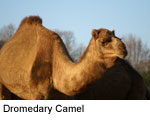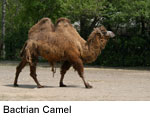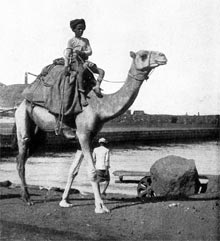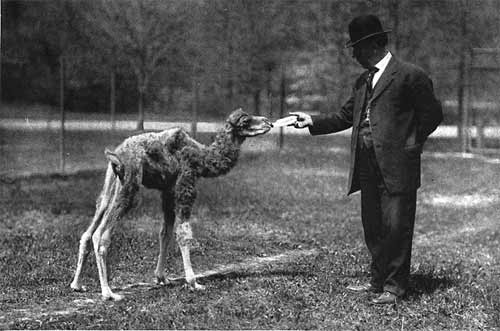  One Hump, Please: The Dromedary camel (Camelus dromedarius) is a large even-toed ungulate native to northern Africa and western Asia, and is the best-known member of the camel family. The Dromedary has one hump on its back, in contrast to the Bactrian camel which has two. The Dromedary is sometimes called an Arabian camel. Some maintain that the name "dromedary" should be used to refer only to racing camels. The average life expectancy of a camel is 30 to 50 years. One Hump, Please: The Dromedary camel (Camelus dromedarius) is a large even-toed ungulate native to northern Africa and western Asia, and is the best-known member of the camel family. The Dromedary has one hump on its back, in contrast to the Bactrian camel which has two. The Dromedary is sometimes called an Arabian camel. Some maintain that the name "dromedary" should be used to refer only to racing camels. The average life expectancy of a camel is 30 to 50 years.
Thick Eyelashes and Small Ears: Male Dromedaries camels have a soft palate, which they inflate to produce a deep pink sack that out of the sides of their mouths during the mating season. Dromedaries are also noted for their thick eyelashes and small, hairy ears. Adults grow to a length of 10 feet and height of six to seven feet. Weight is usually in the range of 1000-1500 pounds.
 Two Humps, Please: The Bactrian camel (Camelus bactrianus) is a large even-toed ungulate native to the steppes of eastern Asia. The Bactrian camel has two humps on its back, in contrast to the Dromedary which has one. Nearly all of the estimated 1.4 million Bactrian camels alive today are domesticated, but in October 2002 the estimated 950 remaining in the wild in northwest China and Mongolia were placed on the critically endangered species list. Two Humps, Please: The Bactrian camel (Camelus bactrianus) is a large even-toed ungulate native to the steppes of eastern Asia. The Bactrian camel has two humps on its back, in contrast to the Dromedary which has one. Nearly all of the estimated 1.4 million Bactrian camels alive today are domesticated, but in October 2002 the estimated 950 remaining in the wild in northwest China and Mongolia were placed on the critically endangered species list.
Just the Facts: Bactrian camels are over 2 meters (7 feet) tall at the hump and weigh in excess of 725 kg (1,600 pounds). They are herbivores, eating grass, leaves, and grains, capable of drinking up to 120 liters (32 US gallons) of water at a time. Their mouth is extremely tough, allowing them to eat thorny desert plants. They are supremely adapted to protect themselves against the desert heat and sand; with wide, padded feet and thick leathery pads on the knees and chest, nostrils that can open and close, ears lined with protective hairs, and bushy eyebrows with two rows of long eyelashes. Thick fur and underwool keep the animal warm during cold desert nights and also insulate against daytime heat.
Camel Olympian: Compared to the Dromedary camel, the Bactrian is a stockier, hardier animal being able to survive the scorching desert heat of northern Iran to the frozen winters in Tibet. The Dromedary is taller and faster, and with a rider it can maintain 8-9 mph for hours at a time. By comparison a loaded Bactrian camel moves at about 2.5 mph
Of Camels and Men: Around the second millennium BC, camels became established to the Sahara region but disappeared again from the Sahara  beginning around 900 BC. The Persian invasion of Egypt under Cambyses introduced domesticated camels to the area. beginning around 900 BC. The Persian invasion of Egypt under Cambyses introduced domesticated camels to the area.
Domesticated camels were used through much of North Africa, and the Romans maintained a corps of camel warriors to patrol the edge of the desert. The Persian camels, however, were not particularly suited to trading or travel over the Sahara; rare journeys made across the desert were made on horse-drawn chariots.
The stronger and more durable Bactrian Camels first began to arrive in Africa in the fourth century. It was not until the Islamic conquest of North Africa, however, that these camels became common. While the invasion was accomplished largely on horseback, the new links to the Middle East allowed camels to be imported en masse.
Police on Camels? These camels were well-suited to long desert journeys and could carry a great deal of cargo. For the first time this allowed substantial trade over the Sahara. Modern domesticated dromedaries are used for milk and meat and as beasts of burden for cargo and passengers. Unlike horses, they kneel for the loading of passengers and cargo. At many of the desert located tourist sites in Egypt, mounted police on camels can be seen.

Gestation in the dromedary lasts around 12 months. Usually a single calf is born, and nursed for up to 18 months. Females are sexually mature after 3 to 4 years, males after 5 to 6 years. Lifespan in captivity is typically about 25 years, with some animals reaching the age of 50.

All text is available under the terms
of the GNU Free Documentation License
|